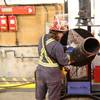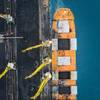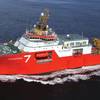Since the birth of the very first large crude carrier (VLCC) - the 206,000-dwt Idemitsu Maru in 1966, the stage was on the verge of being set for another 1,000 large tankers of VLCC size and above that would be built over the next 30 years.
VLCCs are tankers ranging in size from 200,000-320,000-dwt, with a smaller sized version less than 275,000-dwt - equivalent to about two million barrels, which is a common cargo consignment size. The largest VLCCs are 275,000-dwt and above.
Idemitsu Maru was delivered by Japan's IHI shipyard at a time in which tanker sizes were escalating at a very high pace. The vessel, which was constructed to transport oil from the Middle East to Japan, measured 1,128 x 164 ft. (344 x 50 m), with a fully laden draft of 58 ft. (17.7 m). This new vessel fared well as the Suez Canal was closed in 1967, thus making it more economical to deliver oil in large tankers to the U.S. and Europe.
Although most of this oversized fleet was built early on in its inception period, their claim as the largest ship afloat soon became short-lived when in the 1970's, several large ultra-crude carriers (ULCCs), some as large as 550,000-dwt were ordered. The 10-year period proceeding the delivery of Idemitsu Maru spawned the construction of about 650 VLCCs and ULCCs. Some even thought that the ULCCs would be ousted by an even bigger vessel - the million-ton behemoth, which, in actuality never did happen.
The second Arab-Israeli war in 1973 forced the price of oil to skyrocket - right in the midst of this surge of tanker newbuilds. As a result, two-thirds of these new ships were left unwanted - forcing the bottom to drop out of a market that had been on its way to succeeding as the leader in its industry. This oversupply vs. demand, combined with a worldwide economic slump, forced the VLCCs to be moved straight into layup.
The 1980s were not much better as no new tankers were developed during the 20 years that it took just to downsize the massive oversupply of tonnage. But, jumping ahead to the 1990's, the older already existing ships that had been the products of the 1960's VLCC boom now needed upgrades and repairs. This new interest in larger tankers is planted specifically on VLCCs since the once popular ULCCs were now thought of as impractical for today's trading patterns.
Despite all the production and delivery halts that the VLCC market has experienced over the years, these ships have also endured regulatory changes as well - specifically as a result of the Exxon Valdez incident.
Since the infamous incident occurred in Prince William Sound in 1989, all tankers ordered since 1993 must now have required double hulls - a more complex structure than the usual single hull. Although this new rule is one that will help to avoid any future disasters, it places some new constraints on the older, single hull tankers that are closing in on their final runs - about 140 of which will turn 25 within the next three years.
The Marine Pollution (MARPOL) Convention says that if the lifespan of these ships is to be extended to 30 years, they must pass a rigorous special structural survey. Proceeding these surveys, the tankers then must either use a method of carrying cargo called hystrostatic balance loading or be reconfigured with segregated ballast tanks - both options, which cut down the amount of cargo that can be carried.
Today there are about 80 VLCCs totaling 24,000,000-dwt now under construction for about $70 million each. Currently the only VLCC producing countries are Japan, Korean and newcomer China.
Source: The Tanker Newsletter: A Publication of Intertanko
March 2025
 Read the Magazine
Read the Magazine

 Read the Magazine
Read the Magazine
This issue sponsored by:

Securing the Deep: Business Opportunities in Subsea Defense
Subscribe for
Maritime Reporter E-News
Maritime Reporter E-News is the maritime industry's largest circulation and most authoritative ENews Service, delivered to your Email five times per week









